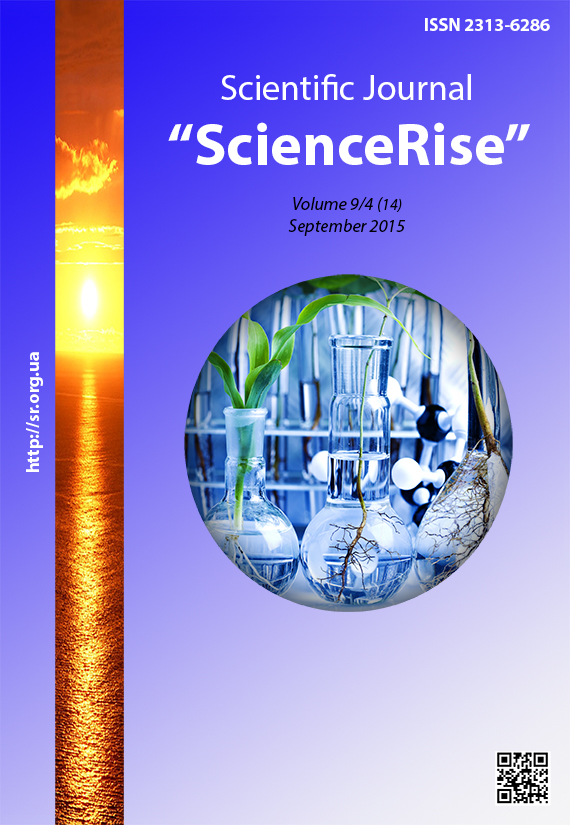Prognostic markers of efficiency of immunosupressive therapy in patients with myelodysplastic syndrome
DOI:
https://doi.org/10.15587/2313-8416.2015.50513Keywords:
myelodysplastic syndrome, cyclosporine A, cytokine, marrowAbstract
Introduction: There is no “gold standard” of the treatment of myelodysplastic synfrom (MDS) for today. Use of the different directions of therapy at MDS is caused by the prognosis of clinical course, age and general state of patient, donor presence and possibility for an adequate attendant therapy. That is why the search of standards of treatment at MDS continues
Aim: To analyze an efficiency of the therapy with cyclosporine A in patients with MDS of the low risk and to detect the new prognostic factors of response to treatment.
Methods: 25 patients with MDS RA were examined according to FAB-classification, 15 women and 10 men whose mean age was 55 years. Statistical analysis of material was carried out using packages of applications STATISTICA for Windows 5,0 and NCSS. Parametric indicators were described as a median [lower-upper quartile] (minimum-maximum). The dynamics of parametric indicators in every group was assessed using Wilcoxon criterion.
Results: During the treatment with cyclosporine A the complete clinical and hematological remission was received in 28 % of patients, the partial remission was fixed in 25 % of patients and hematological improvement according to criteria of the system of International working group (IWG) – in 28 % of treated patients. It was revealed the reliable decrease of TNF-α, TGF-β and IL-6 in the process of treatment that prove the target mechanism of an effect of preparation at myelodysplastic syndrome. An influence of cytokines on the probability of positive result of treatment was not confirmed. It was established that the young age of patients, hypo- or normocellular marrow, an increased rate of lymphocytes in myelogram, an absence of hemotransfusion dependence and the level of hemoglobin higher than 80 g/l cause the better response to treatment with cyclosporine A. TNF-a concentration higher than 8 mg|ml is a marker of an early relapse in patients treated with cyclosporine A
References
Greenberg, P. L., Stone, R. M., Bejar, R., Bennett, J. M., Bloomfield, C. D., Borate, U. et. al (2015). Myelodysplastic Syndromes, Version 2.2015. Featured updates to the NCCN Guidelines. JNCCN Journal of the National Comprehensive Cancer Network, 13 (3), 261–272.
Kastrinaki, M.-C., Pavlaki, K., Batsali, A. K., Kouvidi, E., Mavroudi, I., Pontikoglou, C., & Papadaki, H. A. (2013). Mesenchymal Stem Cells in Immune-Mediated Bone Marrow Failure Syndromes. Clinical and Developmental Immunology, 2013, 1–10. doi: 10.1155/2013/265608
Tomashevska, N. J., Vigovs’ka, J. I., Masliak, Z. V. (2007). Rol’ cytokiniv u patogenezi mielodysplastichnogo sindromu [The role of cytokines in the pathogenesis of Myelodysplastic Syndrome]. Ukrainckii zurnal hematologii I transfuziologii. Ukrainian journal of Haematology and transfusiology, 9 (2), 95–100.
Boehrer, S. (2008). Pathogenesis and targets in Myelodysplastic syndromes. Hematology (EHA Educ. Program), 76–82.
Barrett, A. J., Sloand, E. (2009). Autoimmune mechanisms in the pathophysiology of myelodysplastic syndromes and their clinical relevance. Haematologica, 94 (4), 449–451. doi: 10.3324/haematol.2009.006080
Skvorcov, V. V., Tumarenko, A. V., Skvorcov, E. M. (2009). Mielodisplastichni sindromi [Myelodysplastic syndromes]. Terapevticheskii arhiv. Therapeutic Archive, 8, 32–37.
Kasner, M. T., Luger, S. M. (2009). Update on the therapy for myelodysplastic syndrome. American Journal of Hematology, 84 (3), 177–186. doi: 10.1002/ajh.21352
Aggarwal, S., van de Loosdrecht, A. A., Alhan, C., Ossenkoppele, G. J., Westers, T. M., Bontkes, H. J. (2011). Role of immune responses in the pathogenesis of low-risk MDS and high-risk MDS: implications for immunotherapy. British Journal of Haematology, 153 (5), 568–581. doi: 10.1111/j.1365-2141.2011.08683.x
Risitano, A. M. (2010). Immunosuppressive therapies in the management of immune-mediated marrow failures in adults: where we stand and where we are going. British Journal of Haematology, 152 (2), 127–140. doi: 10.1111/j.1365-2141.2010.08439.x
Malcovati, L., Hellstrom-Lindberg, E., Bowen, D. et. al (2013). Diagnosis and treatment of primary myelodysplastic syndromes in adults: recommendations from the European LeukemiaNet. Blood, 122 (17), 2943–2964. doi: 10.1182/blood-2013-03-492884
Sloand, E. M., Wu, C. O., Greenberg, P., Young, N., Barrett, J. (2008). Factors Affecting Response and Survival in Patients With Myelodysplasia Treated With Immunosuppressive Therapy. Journal of Clinical Oncology, 26 (15), 2505–2511. doi: 10.1200/jco.2007.11.9214
Downloads
Published
Issue
Section
License
Copyright (c) 2015 Ольга Ігорівна Бойко, Звенислава Володимирівна Масляк, Звенислава Володимирівна Масляк, Ярослава Іллівна Виговська, Ярослава Іллівна Виговська, Мар’яна Іванівна Сімонова, Мар’яна Іванівна Сімонова, Наталія Яремівна Томашевська, Наталія Яремівна Томашевська

This work is licensed under a Creative Commons Attribution 4.0 International License.
Our journal abides by the Creative Commons CC BY copyright rights and permissions for open access journals.
Authors, who are published in this journal, agree to the following conditions:
1. The authors reserve the right to authorship of the work and pass the first publication right of this work to the journal under the terms of a Creative Commons CC BY, which allows others to freely distribute the published research with the obligatory reference to the authors of the original work and the first publication of the work in this journal.
2. The authors have the right to conclude separate supplement agreements that relate to non-exclusive work distribution in the form in which it has been published by the journal (for example, to upload the work to the online storage of the journal or publish it as part of a monograph), provided that the reference to the first publication of the work in this journal is included.

